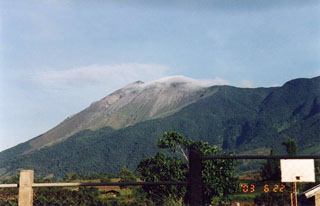Report on Kanlaon (Philippines) — 7 May-13 May 2025
Smithsonian Institution / US Geological Survey
Weekly Volcanic Activity Report, 7 May-13 May 2025
Managing Editor: Sally Sennert.
Please cite this report as:
Global Volcanism Program, 2025. Report on Kanlaon (Philippines) (Sennert, S, ed.). Weekly Volcanic Activity Report, 7 May-13 May 2025. Smithsonian Institution and US Geological Survey.
Kanlaon
Philippines
10.4096°N, 123.13°E; summit elev. 2422 m
All times are local (unless otherwise noted)
The Philippine Institute of Volcanology and Seismology (PHIVOLCS) reported continuing eruptive activity at Kanlaon during 6-13 May. Daily sulfur dioxide emissions ranged from 554 to 3,055 tonnes per day. Gas-and-steam plumes with occasional ash content rose as high as 1 km above the crater rim and drifted NW, W, SW, and SE. Periods of ash emissions were noted on 8 May (5 minutes) and 11 May (27 minutes). The seismic network recorded 5-10 daily volcanic earthquakes during 6-10 May and 63 volcanic earthquakes on 11 May. A total of 135 volcanic earthquakes were detected by the seismic network from 0000 on 11 May to 1200 on 12 May, including relatively strong volcanic-tectonic earthquakes, indicating rock fracturing due to rising magma or gases. A total of 72 volcanic earthquakes (M 0.3-3.1) recorded during 0000-1200 on 12 May were located 0-8 km beneath the N and NW flanks. PHIVOLCS issued an advisory at 1330 on 12 May noting increased seismicity.
A moderately explosive eruption began at 0255 on 13 May and lasted for five minutes based on seismic and infrasound data. Audible rumbling sounds were heard in barangays in Negros Oriental, including Pula and Canlaon City (10 km ESE), and in La Castellana (16 km SW) in Negros Occidental. A voluminous grayish ash plume rose about 4.5 km above the summit and drifted SW. Incandescent pyroclastic density currents descended the S flanks as far as 2 km based on visual and thermal camera monitoring. Large fragments were ejected from the crater a few hundred meters and set vegetation near the summit on fire. Minor ashfall was reported in the barangays of Yubo and Ara-al (La Carlota City, 14 km W), in Ilijan and Binubuhan (Bago City, 30 km NW), and in Biak-na-Bato, Sag-ang, and Mansalanao (La Castellana). According to news articles additional reports of ashfall came from San Carlos City (31 km ENE) and Bacolod (35 km NW), as well from the municipalities of Murcia (24 km NW), San Enrique (29 km W), Valladolid (34 km W), Pontevedra (29 km WSW), Hinigaran (35 km SW), and Binalbagan (38 km SW). A sulfur odor was also reported in several localities. According to the Tokyo VAAC the ash plume rose to 7.9 km (26,000 ft) a.s.l., or 5.5 km above the summit. Dozens of flights in and out of the affected areas were cancelled, and others delayed or rerouted, during 13-14 May. The Alert Level remained at 3 (on a scale of 0-5); the public was warned to stay 6 km away from the summit and pilots were warned not to fly close to the volcano.
Geological Summary. Kanlaon volcano (also spelled Canlaon) forms the highest point on the Philippine island of Negros. The massive andesitic stratovolcano is covered with fissure-controlled pyroclastic cones and craters, many of which are filled by lakes. The largest debris avalanche known in the Philippines traveled 33 km SW from Kanlaon. The summit contains a 2-km-wide, elongated northern caldera with a crater lake and a smaller but higher active vent, Lugud crater, to the south. Eruptions recorded since 1866 have typically consisted of phreatic explosions of small-to-moderate size that produce minor local ashfall.
Sources: Philippine Institute of Volcanology and Seismology (PHIVOLCS), Philippine News Agency (PNA), Air Asia, Cebu Pacific, Philippine Airlines, Tokyo Volcanic Ash Advisory Center (VAAC)

